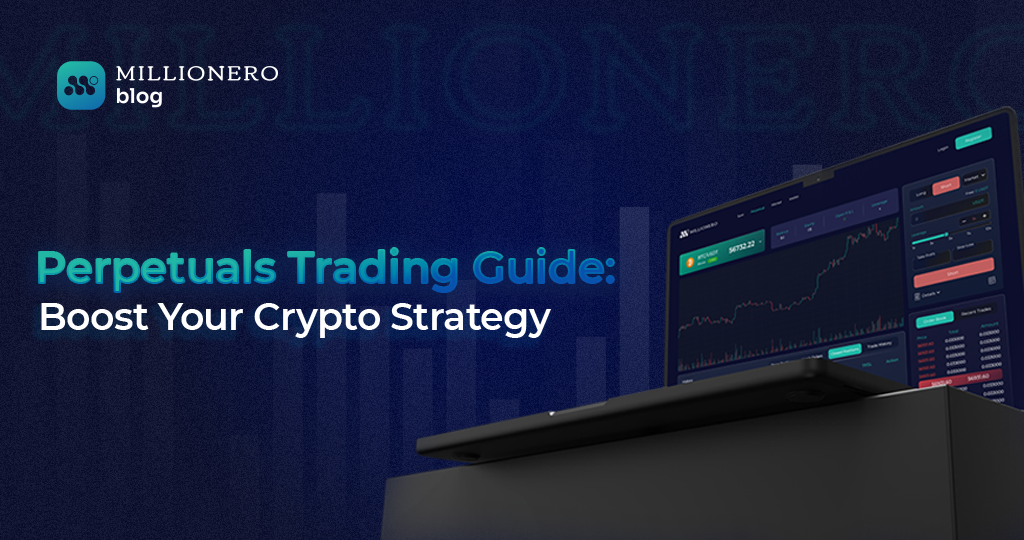
As cryptocurrency evolves, perpetual trading has become a powerful tool for traders. This perpetuals trading guide provides an overview of perpetuals, insights into perpetual trading, and tips to maximize your trading success
What Are Perpetuals?
Perpetuals, also known as perpetual futures or perpetual swaps, are derivative contracts that allow traders to speculate on the price of an asset without an expiration date. Unlike traditional futures contracts, which have a set settlement date, perpetuals can be held indefinitely, offering flexibility to traders. With perpetual trading, you buy or sell a contract based on whether you believe the price of an underlying asset will rise or fall. Your profit or loss depends on the difference between your entry and exit prices.
How to Trade Perpetuals?
Perpetual trading involves buying and selling perpetual contracts, which are popular in the cryptocurrency market due to their flexibility and leverage options. Here’s a simple breakdown of how it works:
- Leverage: Use smaller amounts of capital to control larger positions, amplifying both potential gains and risks.
- Funding Rate: This mechanism ensures the perpetual contract price stays close to the underlying asset’s spot price.
- No Expiry: Unlike other futures contracts, perpetual contracts have no expiration date, allowing traders to hold positions as long as they meet margin requirements.
Perpetual vs. Futures Trading
Here’s how perpetual trading differs from traditional futures trading:
- Expiration Date: Perpetual contracts have no expiration date, while futures contracts do.
- Funding Rate: Perpetuals use funding rates to align with the spot price, unlike traditional futures.
- Trading Flexibility: Perpetuals offer indefinite holding periods, while futures are limited by their expiration dates.
| Perpetual Trading | Future Trading |
| No expiration date | Fixed expiration date |
| Funding rates to maintain parity with a spot price | No funding rates |
| Often have higher leverage | Typically have lower leverage |
| Suitable for long-term positions | Ideal for short-term strategies |
| Less volatile due to approaching expiration date | More challenging to manage risk |
| Continuous and indefinite | Limited and expiring |
Funding Rates in Perpetual Trading
Funding rates are periodic payments between traders that help keep the perpetual contract price close to the spot price. A positive funding rate means long positions pay short positions and vice versa. This mechanism helps control inflation and stabilize price levels.
Leverage in Perpetual Trading
Leverage allows traders to control larger positions with a smaller capital base. For example, with 10x leverage, $1,000 can control a $10,000 position. While leverage can amplify profits, it also increases the risk of significant losses.
Example: If you own 1 Bitcoin worth $30,000 and use futures to hedge, a drop in Bitcoin’s price would increase the value of your futures contract, offsetting potential losses. Conversely, if the price rises, your Bitcoin’s value increases, but the futures contract might lose value.
Liquidation in Perpetual Trading
Perpetuals trading guide – Liquidation occurs when a trader’s margin falls below the required level. To prevent further losses, the position is closed. Understanding how liquidation levels work is crucial to managing risks effectively.
Perpetual Trading Strategies
- Trend Following: Identify and trade according to market trends.
- Range Trading: Buy at support levels and sell at resistance levels within a trading range.
- Scalping: Execute numerous trades to profit from short-term price movements.
How to Trade Perpetuals
- Choose a Platform: Select an exchange offering perpetual contracts. Millionero is ideal for beginners with its user-friendly interface and educational resources.
- Understand the Market: Apply technical analysis to forecast price movements and make informed decisions.
- Manage Risk: Use stop orders to limit risk and avoid trading with excessive capital.
- Monitor Funding Rates: Keep an eye on funding rates as they affect your position’s cost.
Tips for Perpetual Trading Success
- Start Small: Begin with a modest stake to grasp how perpetual trading works.
- Educate Yourself: Continuously study market trends and trading strategies.
- Use Leverage Wisely: Leverage can enhance profits but also increase losses.
- Stay Updated: Keep informed about market developments to make sound trading decisions.
Risk Management in Perpetual Trading
Implement measures such as stop-loss orders, appropriate leverage, and portfolio diversification to manage risk effectively. Set clear objectives and stick to them to control potential losses.
Position Sizing for Perpetual Trading
Position sizing is crucial for risk management. Determine the amount of capital you’re willing to risk on each trade to manage potential losses.
Stop-Loss and Take-Profit Orders
Stop-loss orders help close positions at a specific price to prevent further losses, while take-profit orders close positions at predefined prices to secure profits. Both are essential for managing risk and maximizing gains.
Arbitrage in Perpetual Trading
Arbitrage involves exploiting price differences for the same asset across different platforms or exchanges. Buy low on one platform and sell high on another to earn a profit.
Hedging with Perpetuals
Hedging involves using perpetual contracts to protect your portfolio from potential losses. This strategy helps mitigate risks and safeguard your investments.
Market Analysis and Indicators
- Technical Analysis: Analyze charts and use indicators like Moving Averages, RSI, and MACD to predict price movements.
- Fundamental Analysis: Evaluate economic factors and market conditions to determine an asset’s fair value.
Wrap-Up
Perpetual trading offers a dynamic way to engage with the cryptocurrency market. By understanding the fundamentals and employing sound strategies, you can enhance your trading performance and navigate the complexities of the crypto world with confidence.
Want to learn more about the perpetuals trading guide or crypto world? Visit Millionero to explore the ins and outs of crypto trading and get involved!
Millionero uses TradingView charts to display cryptocurrency data. With interactive charts, useful tools, and an intuitive interface, it’s perfect for tracking BTCUSD prices in real time, along with other cryptocurrency pair rates.

